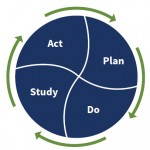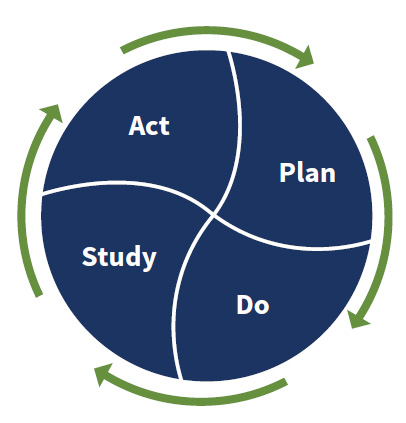Yesterday I spent 20 minutes working with Graham on breathing. It turned out to be a great example of accelerating your learning by using rapid cycle testing. This follows the same steps as in our free template, many times in a single session.
Change idea: Get more air through controlled pop-pop breathing
Cycle: 1
Theory: Pop-pop breathing feels different from how I normally breathe.
Question: What does pop-pop breathing feel like?
Prediction: Different from what I do now
Measures: Bubbles: in a long stream or spaced?
Swim: In a lunge position in shallow end, lower head into water and exhale through nose.
Data: Bubbles come out in a single long stream
Learning: This isn’t pop-pop breathing.
Next time: Space the bubbles
Cycle: 2
Theory: Pop-pop breathing has spaces between the bubbles
Question: How many spaces can I have in a stream of bubbles
Prediction: lots
Measures: Bubbles: spaced or not, how frequently?
Swim: In a lunge position in shallow end, lower head into water and exhale through nose.
Data: Bubbles come out with some spacing. Head submerged for longer than is usual between breaths
Learning: This is how pop-pop breathing feels
Next time: Shorter series of pop-pops, followed by a breath
Cycle: 3
Theory: I need a consistent number of pop-pops between in-breaths
Question: How many pop-pops is the right number before I turn to get air?
Prediction: No idea. Get a baseline.
Measures: Number of pop-pops between turning to air strokes
Swim: 10 strokes, turning to air every right side stroke. Count pops between turning to air strokes.
Data: Seems to be 2 pops, usually. Face red at end of swim. Not getting enough air.
Learning: Need to make adjustments. Not getting enough air this way.
Next time: More pops.
Cycle: 4
Theory: More pops out will empty lungs more, so more air flows in when I turn to air
Question: How many pops can I fit in between turning to air strokes?
Prediction: Four is too many
Measures: Number of pop-pops between turning to air strokes. Enough air in, on 1 – 5 scale. Face colour at end of swim.
Swim: 10 strokes, turning to air every right side stroke. 4 pops between turning to air strokes.
Data:Never 4 pops. Sometimes 3 pops. Sometimes 2. Air in 3. Red face.
Learning: 4 pops is too many.
Next time: Fewer pops
Cycle: 5
Theory: Consistently 3 pops will allow me to get enough air in.
Question: How many pops can I fit in between turning to air strokes?
Prediction: Three
Measures: Number of pop-pops between turning to air strokes. Enough air in, on 1 – 5 scale. Face colour at end of swim.
Swim: 10 strokes, turning to air every right side stroke. 3 pops between turning to air strokes.
Data: All over the place. Some 3 pops, some 2 pops. Felt really uncoordinated. Air in 3. Red face.
Learning: Pop-pops need to be based on consistent stroke tempo.
Next times: Do the same thing with a tempo trainer to keep stroke timing consistent.
Cycle: 6
Theory: Consistent stroke timing will allow consistent pop-pop breathing.
Question: How many pops can I fit in between turning to air strokes, at my preferred tempo (1.15)?
Prediction: Three
Measures: Number of pop-pops between turning to air strokes. Enough air in, on 1 – 5 scale. Face colour at end of swim.
Swim: Tempo 1.15. 10 strokes, turning to air every right side stroke. 3 pops between turning to air strokes.
Data: No data
Learning: Too many things to think about.
Next time: Match strokes to the beep of tempo trainer.
Cycle: 7
Theory: Focussing on the beep in one swim will mean I don’t have to think about the beep later.
Question: How does it feel to swim at 1.15 tempo? Can I maintain it?
Prediction: Will match to beep.
Measures: All strokes matched to beep, or not?
Swim: Tempo 1.15. 10 strokes, turning to air every right side stroke. Match hand entry to beep.
Data: All hand entries matched to beep.
Learning: Body now feels the tempo. Ready to focus on something else.
Next time: Focus on pop-pops again.
Cycle: 8
Theory: Number of pop-pops depends on tempo – slower tempo means more pops
Question: How many pops can I fit in between turning to air strokes, at my preferred tempo (1.15)?
Prediction: Two
Measures: Number of pop-pops between turning to air strokes. Enough air in, on 1 – 5 scale. Face colour at end of swim
Swim: Tempo 1.15. 10 strokes, turning to air every right side stroke. 2 pops between turning to air strokes.
Data: Consistently matched to tempo trainer beep. Consistently 2 pops between turning to air strokes. Air in 5. Face normal colour.
Learning: Two pops is right for me when swimming at tempo 1.15.
Next time: Repeat this a couple of times to check this data is reliable.
Cycle: 11
[actually, several cycles gradually slowing tempo]
Theory: Consistent stroke timing will allow consistent pop-pop breathing.
Question: How does it feel to swim at 1.35 tempo? Can I match to beep?
Prediction: Will match to beep
Measures: All strokes matched to beep, or not?
Swim: Tempo 1.35. 10 strokes, turning to air every right side stroke. Match hand entry to beep.
Data: All hand entries matched to beep.
Learning: Body now feels the tempo. Ready to focus on something else.
Next times: Focus on pop-pops again.
Cycle: 12
Theory: Pop-pops depends on tempo – slower tempo might mean more pops, or might mean more languid pops
Question: How many pops can I fit in between turning to air strokes, at tempo 1.35?
Prediction: Three
Measures: Strokes matched to beep. Number of pop-pops between turning to air strokes. Face colour at end of swim
Swim: Tempo 1.35. 10 strokes, turning to air every right side stroke. 3 pops between turning to air strokes.
Data: Consistently matched to tempo trainer beep. Number of pop-pops variable – 2 or 3 or missing breath in order to add pops. Air in 3. Face red.
Learning: Increasing pops doesn’t work.
Next time: Try making each pop more languid
 Cycle: 13
Cycle: 13
Theory: Slower tempo needs more languid pops
Question: How many pops do I need at tempo 1.35, if I make them more languid?
Prediction: Two
Measures: Strokes matched to beep. Number of pop-pops between turning to air strokes. Enough air in, on 1 – 5 scale. Face colour at end of swim
Swim: Tempo 1.35. 10 strokes, turning to air every right side stroke. 2 pops between turning to air strokes.
Data: Consistently matched to tempo trainer beep. 2 pop-pops. Air in 5. Face normal colour.
Learning: Number of pops stays the same at different tempos; spacing between pops changes.
Next time: Repeat to check if this data is reliable.
Cycle: 14 and 15
Data as cycle 13
Theory at end of session
I feel I get enough air when I exhale with 2 pops between turning to air strokes. When I swim at faster tempo the spacing between pops is closer. When I swim at slower tempo the pops are more languid.
And what will Graham practise, in his pool sessions? More of the same, with each cycle extended, testing under different conditions to match the pop-pop to the tempo, with and without tempo trainer, and over longer swims. Will he continue to get enough air at tempos faster than 1.15 and slower than 1.35? Will he continue to get enough air at his full range of tempos when he increases distance to 25m, then 50m, then 100m? Will he be able to get enough air when he swims without the tempo trainer? Our 20 minutes of rapid cycle testing has set Graham up for ongoing learning and improvement over a number of swim sessions.
How many learning opportunities can you create in one session? What change idea could you work on in rapid cycles? (Graham’s theory of knowledge applies to his system; it may not apply to yours.) Comment below on how you learn from rapid cycle testing.

